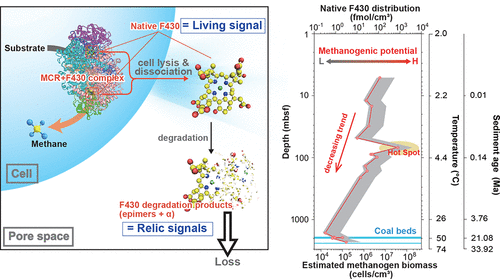Our official English website, www.x-mol.net, welcomes your feedback! (Note: you will need to create a separate account there.)
Insights into the Methanogenic Population and Potential in Subsurface Marine Sediments Based on Coenzyme F430 as a Function-Specific Biomarker
JACS Au Pub Date : 2021-09-13 , DOI: 10.1021/jacsau.1c00307 Masanori Kaneko 1, 2 , Yoshinori Takano 2 , Masashi Kamo 3 , Kazuya Morimoto 1 , Takuro Nunoura 4 , Naohiko Ohkouchi 2
JACS Au Pub Date : 2021-09-13 , DOI: 10.1021/jacsau.1c00307 Masanori Kaneko 1, 2 , Yoshinori Takano 2 , Masashi Kamo 3 , Kazuya Morimoto 1 , Takuro Nunoura 4 , Naohiko Ohkouchi 2
Affiliation

|
Coenzyme F430, the prosthetic group of methyl coenzyme M reductase (MCR), is a key compound in methane metabolism. We applied coenzyme F430 as a function-specific biomarker of methanogenesis to subsurface marine sediments collected below the sulfate reduction zone to investigate the distribution and activity of methanogens. In addition, we examined the kinetics of the epimerization of coenzyme F430, which is the first stage of the degradation process after cell death, at various temperatures (4, 15, 34, 60 °C) and pH (5, 7, 9) conditions, which cover in situ conditions of drilled sediments used in this study. The degradation experiments revealed that the kinetics of the epimerization well follow the thermodynamic laws, and the half-life of coenzyme F430 is decreasing from 304 days to 11 h with increasing the in situ temperature. It indicates that the native F430 detected in the sediments is derived from living methanogens, because the abiotic degradation of F430 is much faster than the sedimentation rate and will not be fossilized. Based on coenzyme F430 analysis and degradation experiments, the native form of F430 detected in subseafloor sediments off the Shimokita Peninsula originates from living methanogen cells, which is protected from degradation in cells but disappears soon after cell death. The biomass of methanogens calculated from in situ F430 concentration and F430 contents in cultivable methanogen species decreases by 2 orders of magnitude up to a sediment depth of 2.5 km, with a maximum value at ∼70 m below the seafloor (mbsf), while the proportion of methanogens to the total prokaryotic cell abundance increases with the depth, which is 1 to 2 orders of magnitude higher than expected previously. Our results indicate the presence of undetectable methanogens using conventional techniques.
中文翻译:

基于辅酶 F430 作为功能特异性生物标志物对地下海洋沉积物中产甲烷种群和潜力的洞察
辅酶 F430 是甲基辅酶 M 还原酶 (MCR) 的辅基,是甲烷代谢的关键化合物。我们将辅酶 F430 作为产甲烷的功能特异性生物标志物应用于收集在硫酸盐还原带下方的地下海洋沉积物,以研究产甲烷菌的分布和活性。此外,我们检查了辅酶 F430 的差向异构化动力学,这是细胞死亡后降解过程的第一阶段,在不同温度(4、15、34、60°C)和 pH 值(5、7、9)下条件,涵盖了本研究中使用的钻孔沉积物的原位条件。降解实验表明,差向异构化动力学符合热力学规律,辅酶 F430 的半衰期从 304 天减少到 11 小时现场温度。这表明在沉积物中检测到的原生 F430 来源于活产甲烷菌,因为 F430 的非生物降解速度远快于沉降速度,不会被化石化。根据辅酶 F430 分析和降解实验,在下北半岛海底沉积物中检测到的天然形式的 F430 来自活产甲烷菌细胞,该细胞在细胞中不会被降解,但在细胞死亡后很快消失。原位计算的产甲烷菌生物量可培养产甲烷菌物种中的 F430 浓度和 F430 含量下降 2 个数量级,直至沉积物深度为 2.5 km,最大值在海底以下约 70 m (mbsf),而产甲烷菌占原核细胞总丰度的比例随着深度的增加而增加,比之前预期的高 1 到 2 个数量级。我们的结果表明使用常规技术无法检测到产甲烷菌的存在。
更新日期:2021-10-25
中文翻译:

基于辅酶 F430 作为功能特异性生物标志物对地下海洋沉积物中产甲烷种群和潜力的洞察
辅酶 F430 是甲基辅酶 M 还原酶 (MCR) 的辅基,是甲烷代谢的关键化合物。我们将辅酶 F430 作为产甲烷的功能特异性生物标志物应用于收集在硫酸盐还原带下方的地下海洋沉积物,以研究产甲烷菌的分布和活性。此外,我们检查了辅酶 F430 的差向异构化动力学,这是细胞死亡后降解过程的第一阶段,在不同温度(4、15、34、60°C)和 pH 值(5、7、9)下条件,涵盖了本研究中使用的钻孔沉积物的原位条件。降解实验表明,差向异构化动力学符合热力学规律,辅酶 F430 的半衰期从 304 天减少到 11 小时现场温度。这表明在沉积物中检测到的原生 F430 来源于活产甲烷菌,因为 F430 的非生物降解速度远快于沉降速度,不会被化石化。根据辅酶 F430 分析和降解实验,在下北半岛海底沉积物中检测到的天然形式的 F430 来自活产甲烷菌细胞,该细胞在细胞中不会被降解,但在细胞死亡后很快消失。原位计算的产甲烷菌生物量可培养产甲烷菌物种中的 F430 浓度和 F430 含量下降 2 个数量级,直至沉积物深度为 2.5 km,最大值在海底以下约 70 m (mbsf),而产甲烷菌占原核细胞总丰度的比例随着深度的增加而增加,比之前预期的高 1 到 2 个数量级。我们的结果表明使用常规技术无法检测到产甲烷菌的存在。



























 京公网安备 11010802027423号
京公网安备 11010802027423号